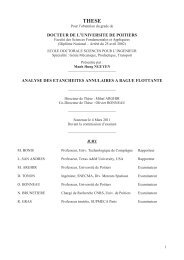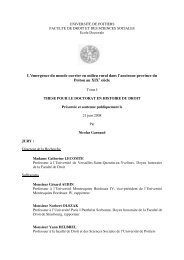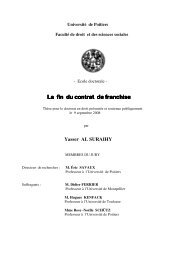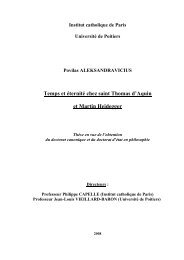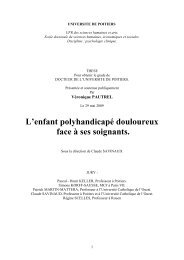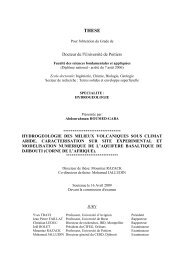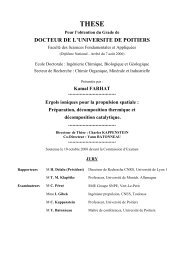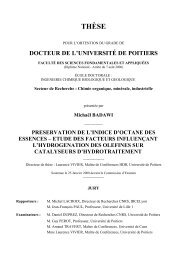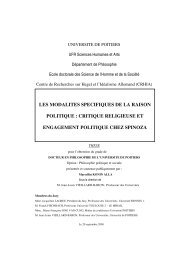Etude et développement d'un actionneur plasma à décharge à ...
Etude et développement d'un actionneur plasma à décharge à ...
Etude et développement d'un actionneur plasma à décharge à ...
Create successful ePaper yourself
Turn your PDF publications into a flip-book with our unique Google optimized e-Paper software.
Annexes<br />
function reveals that a natural frequency of approximately 90 Hz drives the vortex shedding. The quasi-steady<br />
actuation results in a partial flow reattachment over 70% of the chord, and the flow remains attached along the<br />
acquisition sequence. The analysis of the unsteady actuation performed at different frequencies (with a low dutycycle<br />
value resulting in trains of single sine pulse) demonstrates that the unsteady mode is not more efficient<br />
than the steady one to control the separated airflow. The <strong>plasma</strong> effects depend strongly on the applied<br />
frequency, and the most effective actuation is performed with a reduced frequency of F + =1.5. The present results<br />
also demonstrate that a stationary flow reattachment is realized for duty-cycle value s<strong>et</strong> to 50% while reducing<br />
the duty-cycle has d<strong>et</strong>rimental effects on the control performance. The last part of this study is dedicated to the<br />
temporal characterization of the reattachment. The global analysis of the acquisitions for quasi-steady and<br />
unsteady actuations reveals a similar reattachment process. It appears that the electric wind is not able to produce<br />
beneficial vorticity by itself. However the actuation can promote a merging of the natural vortices. This<br />
energization of a large scale flow structure by the electric wind modifies the topology of the succeeding vortex<br />
shedding. In particular, few milliseconds after the beginning of the actuation, the trajectory of the vortex is<br />
changed and a small vortex rolls along the suction side with a sense of rotation promoting a momentum transfer<br />
toward the boundary layer. Through the observation of the time-resolved PIV fields, it seems that the vortex<br />
merging initiates the control process while the small vortex rolling along the airfoil surface seems responsible of<br />
the flow reattachment.<br />
References<br />
1 Corke, T.C., and Post, M.L., “Overview of <strong>plasma</strong> flow control: concepts, optimization and applications,” AIAA paper<br />
2005-563, 2005.<br />
2 Moreau, E., “Airflow control by non-thermal <strong>plasma</strong> actuators,” Journal of physics D: applied Physics, Vol. 40, No. 3,<br />
2007, pp.605-636.<br />
3 Tsubakino, D., Tanaka, Y., and Fujii, K., “Effective layout of <strong>plasma</strong> actuators for a flow separation control on a wing,”<br />
AIAA paper 2007-474, 2007.<br />
4 Corke, T.C., Jumper, E.J., Post, M., Orlov, D., and McLaughlin, T.E., “Applications of weakly-ionized <strong>plasma</strong>s as wing<br />
flow-control devices,” AIAA paper 2002–0350, 2002.<br />
5 Roth, J.R., “Aerodynamic flow acceleration using paraelectric and peristaltic electrohydrodynamic effects of a One<br />
Atmosphere Uniform Glow Discharge Plasma,” Physics of <strong>plasma</strong>s, Vol. 10, No.5, 2003, pp.2117–26<br />
6 Roth, J.R., Sin, H., Madhan, R.C.M., and Wilkinson, S.P., “Flow re-attachment and acceleration by paraelectric and<br />
peristaltic electrohydrodynamic (EHD) effects,” AIAA paper 2003-531.<br />
7 Corke, T.C., He, C. and Patel, M.P., 2004, “Plasma flaps and slats: an application of weakly-ionized <strong>plasma</strong> actuators,”<br />
AIAA paper 2004-2127.<br />
8 Post, M., and Corke, T.C., “Separation Control Using Plasma Actuators: Dynamic Stall Vortex Control on Oscillating<br />
Airfoil,” AIAA journal, Vol. 44, No. 12, pp.3125-3135.<br />
9 Sosa, R., Moreau, E., Touchard, G. and Artana, G., 2007, “Stall control at high angle of attack with <strong>plasma</strong> she<strong>et</strong><br />
actuators,” Experiments in fluids, Vol. 42, No. 1, pp. 143–167.<br />
10 Göksel, B., Greenblatt, D., Rechenberg, I., Nayeri, C.N. and Paschereit, C.O., 2006, “Steady and unsteady <strong>plasma</strong> wall<br />
j<strong>et</strong>s for separation and circulation control,” AIAA paper 2006-3686.<br />
11 Post, M.L., and Corke, T.C., “Separation control on high angle of attack airfoil using <strong>plasma</strong> actuators,” AIAA paper<br />
2003-1024, 2003.<br />
12 Corke, T.C., Mertz, B. and Patel, M.P., 2006, “Plasma flow control optimized airfoil,” AIAA paper 2006-1208, 2006.<br />
13 Orlov, D., Apker, T., He, C., Othman, H., and Corke, T.C., “Modeling and Experiment of Leading Edge Separation<br />
Control Using SDBD Plasma Actuators,” AIAA paper 2007-0877, 2007.<br />
14 Mabe, J.H., Calkins, F.T., Wesley, B., Woszidlo, R., Taubert, L., and Wygnanski, I., “On the Use of Single Dielectric<br />
Barrier Discharge Plasma Actuators for Improving the Performance of Airfoils,” AIAA paper 2007-3972, 2007.<br />
15 Enloe, C.L., McLaughlin, T.E., VanDyken, R.D., Kachner, K.D., Jumper, E.J., and Corke, C., “Mechanisms and<br />
responses of a single dielectric barrier <strong>plasma</strong> actuator: Plasma morphology,” AIAA Journal, Vol. 42, No. 3, 2004, pp.589-<br />
594.<br />
16Roth, J.R., “Electrohydrodynamically induced airflow in a one atmosphere uniform glow discharge surface <strong>plasma</strong>,”<br />
25th IEEE Int. Conf. Plasma Science, 1998.<br />
17 Roth, J.R., Sherman, D.M., and Wilkinson, S.P., “Electrohydrodynamic Flow Control with a Glow-Discharge Surface<br />
Plasma,” AIAA Journal, Vol. 38, No. 7, 2000, pp.1166-1172.<br />
18 Enloe, C.L., McLaughlin, T.E., VanDyken, R.D., Kachner, K.D., Jumper, E.J., and Corke, C., “Mechanisms and<br />
responses of a single dielectric barrier <strong>plasma</strong> actuator: Plasma morphology,” AIAA Journal, Vol. 42, No. 3, 2004, pp.589-<br />
594.<br />
19Font, G.I., “Boundary layer control with atmospheric <strong>plasma</strong> discharges,” AIAA paper 2004-3574, 2004.<br />
20 Pons, J., Moreau, E. and Touchard, G., “Asymm<strong>et</strong>ric surface barrier discharge in air at atmospheric pressure: electric<br />
properties and induced airflow characteristics,” Journal of physics D: applied physics, Vol. 38, No. 19, 2005, pp.3635-3642.<br />
21 Boeuf, J.P., Lagmich, Y., Unfer, T.H., Callegari, T.H. and Pitchford, L.C., “Electrohydrodynamic force in dielectric<br />
barrier discharge <strong>plasma</strong> actuator,” Journal of physics D: applied physics Vol. 40, No. 3, 2007, pp.652-662.<br />
22 Roth, J.R. and Dai, X., 2006, “Optimization of the aerodynamic <strong>plasma</strong> actuator as an EHD electrical device,” AIAA<br />
paper 2006-1203.<br />
- 195 -



